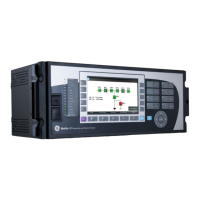GE Multilin D60 Line Distance Protection System 5-337
5 SETTINGS 5.7 CONTROL ELEMENTS
5
• GND DIR O/C REV: This setting defines the FlexLogic operand (if any) of a protection element that is used in addition
to zone 4 for identifying reverse faults, and thus, for initiating the blocking signal. Either reverse-looking directional or
non-directional overcurrent protection element may be used as GND DIR O/C REV.
Even though any FlexLogic operand could be used as GND DIR O/C REV, enabling the user to combine responses of var-
ious protection elements or to apply extra conditions through FlexLogic equations, this extra signal is primarily meant
to be the output operand from either the negative-sequence directional, neutral directional, or a non-directional instan-
taneous overcurrent element.
The selected protection element (or elements in combination) should be coordinated with the selection of
GND DIR O/C
FWD. For all the forward external faults seen by an element used as GND DIR O/C FWD at one end of the line, the
reverse-looking element used as
GND DIR O/C REV at the other end should pickup and provide a blocking signal. For
greater security and to overcome spurious directional element operation during transients, adding a pickup delay
greater than the pilot channel delay to the reverse directional element is recommended.
• BLOCK SCHEME NO OF COMM BITS: This setting specifies the number of bits of the communications channel avail-
able for the scheme. With only one bit available, the scheme sends the blocking signal by asserting the DIR BLOCK TX
INIT
FlexLogic operand. This operand should be used to start the channel (set the blocking signal). On internal faults,
the scheme removes the blocking signal by asserting the DIR BLOCK TX1 FlexLogic operand.
For tripping the scheme responds to lack of the blocking signal on bit 1 (BLOCK SCHEME RX1 setting). The scheme uses
only local fault type identification provided by the phase selector to assert the output operands DIR BLOCK TRIP A, B, C
and 3P. Please refer to the Theory of operation chapter for more information on communications.
To take advantage of the four-bit blocking scheme, the blocking signals should be initiated from a disturbance detector.
This can be accomplished by using both 50DD and DIR BLOCK TX INIT to assert the blocking signal. Subsequently, spe-
cific bits will be de-asserted by the scheme based on the phase selection providing the peer relay with more informa-
tion on the fault type. Otherwise, the peer relay issues a three-pole trip upon receiving the bit pattern (0, 0, 0, 0).
• BLOCK SCHEME RX1 through BLOCK SCHEME RX4: These settings allow the user to select the FlexLogic oper-
ands that represent the receive signals for the scheme. Typically input contacts interfacing with a signaling system are
used. In single-bit applications,
BLOCK SCHEME RX1 must be used. In two-bit applications, BLOCK SCHEME RX1 and
BLOCK SCHEME RX2 must be used. In four-bit applications, BLOCK SCHEME RX1, BLOCK SCHEME RX2, BLOCK SCHEME
RX3, and BLOCK SCHEME RX4 must be used.

